As biggest Mazda, CX-9 fills key niche
An automobile company is only as good as its customers determine. If its cars are too big, too small, too bulky, too stodgy, well, you can go down the road a ways and find a company that might more closely fit what you’re looking for.
Mazda, meanwhile, a comparatively small Japanese company, must be eavesdropping. Maybe there’s a wiretap. Or at the very least, they’ve been reading my mail. Because Mazda continues to make vehicles that impress me; no weaknesses, just assets. It holds over to their array of SUVs, too. I thought the first CX-9 was too big and a little ungainly, while the CX-7 was sporty and quick, but not economical enough.
When Mazda reorganized its engine and drivetrain manufacturing, and restyled its sedans, it came up with the CX-5, a midsize SUV that handles like a sports car and is perfectly compact. In the last year, Mazda brought out the CX-3, which is smaller and more compact, to the point that even I, who prefers as compact as you dare, find the back seat pretty cramped, if you intend for any humans more than 12 years old to ride back there.
Meantime, before redesigning its outstanding sedans — the compact Mazda3 and the midsize Mazda6 — the company came out with a completely redone CX-9 a year ago. Its largest SUV will satisfy the most discerning fancier of larger SUVs, who like to complain about compact crossovers being too small.
We got a chance to test-drive a 2017 Mazda CX-9, and my wife Joan, agreed with me about every characteristic of the vehicle. It was stunning to look at, in “snowflake white pearl,” which made the vehicle fairly glimmer in any light, and even stand out at nighttime.
The look of the CX-9 also impresses, because it has a bold and forceful open grille, with the top protruding a bit in an aggressively sporty manner. From the side, the silhouette makes a striking pose also, looking lower than it is, and sleek from front to rear, with all the contours and grooves fitting in well with the sometimes mystical concepts Mazda has for its flowing design.
Under the hood, Mazda’s jewels of technology prevail in every model, since the company went to its holistic “Skyactiv” design for creating engine that unify intake, exhaust, combustion chambers and everything else, internally as well as externally.
For those whose eyes glaze over when you talk about such technicalities, suffice it to say that Mazda gets more power and more fuel economy out of a given engine displacement than any other company, in normally aspirated form.
In its sedans and smaller SUVs, Mazda uses either a 2.0 or 2.5 liter 4-cylinder, mating it to its own house-built 6-speed manual or automatic transmissions. But Mazda also has taken well to turbocharging, which is a method for forcing more air-fuel mixture into the engine to let it create more power when needed.
And since the CX-9 is its biggest vehicle — its flagship — Mazda wanted to make sure it had adequate power available. So it took the 2.5-liter 4 and turbocharged it up to 250 horsepower with 310 foot-pounds of torque. It will tow 3,500 pounds of trailer, Mazda says, and after driving one, you believe them.
The pearly white test vehicle we had was stunning from the outside, but even moreso once you climbed aboard. The seats were a soft color, called sand, and were of a luxuriously soft leather. The wood trim was real wood, supplied, we’re told, by a Japanese guitar making company. The metal trim is also real aluminum.
Driving position is what you’d expect from a company that makes driving enjoyment an uncompromising necessity. The steering wheel has easily operated controls, and the LED headlights have an automatic setting as well as adaptive cornering, which means the lights shine around the curve or corner you’re approaching, and the high beams drop down when set on automatic and you approach an oncoming car.
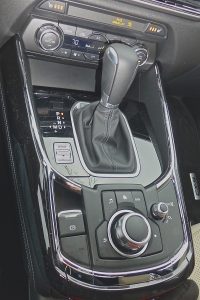
The center console control panel has a versatile center knob that puts your choice onto the upper navigation screen.
The center console has various switches, with a large, round knob that governs everything. You can hit the audio switch, or the navigation, or a home switch, and you get your desired adjustable screen to pop up on the large screen.
The feeling is luxury, but solid luxury. Mazda also moves the CX-9 up in stature with the price tag. The CX-3 is a bargain in the mid-$20,000 range, and the CX-5 is possibly the perfect compact crossover at just under $30,000, with the revised 2017 due out by midsummer. The CX-9 moves up to $40,000, but its lavish equipment makes that seem a bargain next to competitive vehicles.
The rear seats also are supportive and comfortable buckets, and one feature I’ve always liked about the CX-9 is carried over to the new one — wide rear door, which open far enough to allow you to easily flip the backrests forward and climb into the third row. It might be a haven for teenagers.
“It’s big,” said my wife, Joan, “but it never feels too big.” Well put.
Lots of room, all usable, and yet the contours of the exterior round off the sharp corners and make the CX-9 feel more compact than huge.
The large 20-inch alloy wheels and all-season tires worked well during a late-winter snowstorm, and the all-wheel drive was much appreciated before the plows came by.
The independent front and rear suspension keeps the CX-9 taut and flat in all cornering maneuvers, and Mazda obviously has put a lot of work into making its electric power-assisted steering retain excellent feel. Mazda packed a lot of creature features into the CX-9 beyond the expected.
Things like stability control, traction control, roll stability control, plus lane departure warning and back-up cameras are expected these days, but augmented by cross-traffic alert at the rear and lane keep assist, if you seem to be having trouble staying in your proper lane. Rain-sensing wipers are a nice feature always, and the intermittent rear wiper is neat in sloppy conditions.
Privacy side-window shades on the rear windows is impressive on bright days. As usual, you can play around with the electronics and set your own template for what you prefer, but one feature Joan and I disagreed on were the automatic locks.
We both like remote-switch unlocking as you approach a locked car, but how about when you leave? Generally, I’ve never had a problem remembering to lock my vehicles when I park. But with the CX-9, if you get out and walk away and forget to lock it, the thing locks all its doors after 60 seconds, or whatever you set the timer for.
Joan didn’t like it because stopping for a quick drop off or pick up means returning immediately to the car and finding its doors locked, when you specifically left them unlocked. Maybe that’s a nuisance in some cases, but I grew to appreciate it during my week with the CX-9.
There were a couple times when we stopped, parked, and walked away, then remembered an item we wanted and hustled back a few steps before hitting the remote lock. Didn’t matter. The doors were locked. Joan hated it, but I thought it made great sense. You never have to wander off shopping and then start wondering if you locked your CX-9. Because if you didn’t, it will lock itself for you.


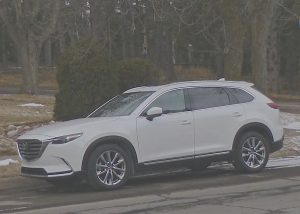
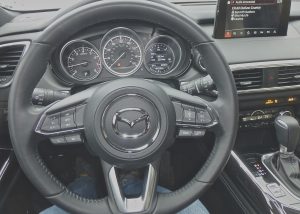
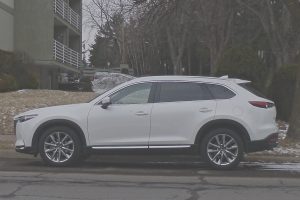
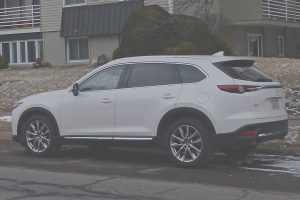
 John Gilbert is a lifetime Minnesotan and career journalist, specializing in cars and sports during and since spending 30 years at the Minneapolis Tribune, now the Star Tribune. More recently, he has continued translating the high-tech world of autos and sharing his passionate insights as a freelance writer/photographer/broadcaster. A member of the prestigious North American Car and Truck of the Year jury since 1993. John can be heard Monday-Friday from 9-11am on 610 KDAL(www.kdal610.com) on the "John Gilbert Show," and writes a column in the Duluth Reader.
John Gilbert is a lifetime Minnesotan and career journalist, specializing in cars and sports during and since spending 30 years at the Minneapolis Tribune, now the Star Tribune. More recently, he has continued translating the high-tech world of autos and sharing his passionate insights as a freelance writer/photographer/broadcaster. A member of the prestigious North American Car and Truck of the Year jury since 1993. John can be heard Monday-Friday from 9-11am on 610 KDAL(www.kdal610.com) on the "John Gilbert Show," and writes a column in the Duluth Reader.